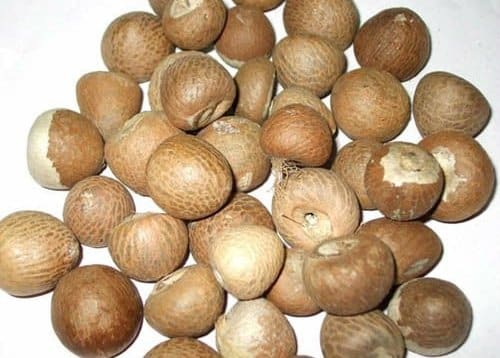
Introduction
- Common Name: Arecanut, Betel Nut, Supari
- Botanical Name: Areca catechu
- Family: Arecaceae (Palm family)
- Chromosome Number: 2n = 32
- Origin: Malaysia, Philippines, and South Asia
- Economic Importance:
- Chewed with betel leaves (paan) in India, Sri Lanka, Bangladesh, etc.
- Used in medicines, dyes, and tannins.
- A key cash crop supporting lakhs of farmers in India.
Distribution in India
- India is the largest producer and consumer of arecanut.
- Major producing states:
- Karnataka (40% of total production)
- Kerala
- Assam
- West Bengal
- Tamil Nadu
- Maharashtra
- Odisha
- Tripura
- Major Arecanut-growing districts:
- Karnataka: Shimoga, Uttara Kannada, Chikmagalur, Dakshina Kannada.
- Kerala: Kasaragod, Malappuram.
- Assam: Darrang, Cachar.
Climatic & Soil Requirements
Climatic Requirements
- Grows well in tropical and subtropical climates.
- Temperature: 14–36°C (Ideal: 25–32°C).
- Rainfall: 1250–4500 mm annually (requires evenly distributed rainfall).
- Altitude: Grows well at 600–1000 m above sea level.
- Prefers high humidity and moderate shade during early growth.
Soil Requirements
- Best soil: Well-drained loamy soils rich in organic matter.
- pH Range: 5.5–6.5 (Slightly acidic to neutral).
- Grows in lateritic, alluvial, and red loamy soils.
- Waterlogging should be avoided.
Important Varieties in India
|
Region |
Popular Varieties |
|
Karnataka |
Mangala, Sumangala, Sree Mangala |
|
Kerala |
Mohitnagar, Kahikuchi |
|
Assam |
Assam Type, Kahikuchi |
|
West Bengal |
Mettupalayam |
|
Tamil Nadu |
Srimangala, Thirthahalli |
Propagation & Planting
Propagation
- Mainly propagated through seeds.
- Selection of Seeds:
- Choose disease-free, fully mature nuts (10–12 months old).
- Soak in water for 24 hours before sowing.
Nursery Preparation
- Raised bed: 1.5 m × 1 m × 25 cm.
- Sow seeds at 2–3 cm depth and maintain moisture.
- Seedlings emerge in 45–60 days and are ready for transplanting in 12–18 months.
Planting Method
- Spacing: 2.7 m × 2.7 m (high-density planting: 2.0 m × 2.0 m).
- Pit size: 60 cm × 60 cm × 60 cm.
- Planting time: June–September (monsoon planting preferred).
- Apply 10 kg FYM, 100 g rock phosphate in each pit before planting.
Irrigation & Nutrient Management
Irrigation
- Summer: Every 4–5 days.
- Winter: Every 10–12 days.
- Methods:
- Drip irrigation is preferred to save water.
- Basin irrigation is common in traditional farming.
Nutrient Management
|
Nutrient |
Requirement (kg/ha) |
Application Time |
|
FYM |
12–15 tons |
Before planting |
|
Nitrogen (N) |
100–120 kg |
In 2–3 split doses |
|
Phosphorus (P₂O₅) |
40–50 kg |
Basal application |
|
Potassium (K₂O) |
100–120 kg |
Along with nitrogen |
|
Micronutrients |
Boron, Zinc |
Foliar spray if deficiency occurs |
Flowering, Pollination & Fruit Development
- Arecanut is cross-pollinated, mainly by wind and insects.
- Flowering starts after 4–6 years of planting.
- Pollination rate is enhanced by intercropping different varieties.
Pest & Disease Management
Major Pests
|
Pest |
Symptoms |
Control Measures |
|
Red Palm Weevil |
Holes in stem, yellowing of leaves |
Use Carbaryl or Chlorpyrifos |
|
Mites |
Yellow spots on leaves |
Spray Neem oil or Acaricides |
|
Root Grubs |
Damages roots, slow growth |
Apply Neem cake in soil |
|
Spindle Bug |
Deformation of leaves |
Spray Dimethoate |
Major Diseases
|
Disease |
Symptoms |
Control Measures |
|
Koleroga (Mahali Disease) |
Rotting of young nuts |
Spray Bordeaux mixture (1%) |
|
Bud Rot |
Decay of the growing bud |
Use Copper fungicides |
|
Inflorescence Dieback |
Drying of flower stalks |
Apply Mancozeb or Carbendazim |
|
Root Wilt |
Yellowing, stunted growth |
Improve drainage, use Trichoderma |
Harvesting & Yield
Harvesting
- First Harvest: After 4–6 years.
- Maturity Stage: 8–9 months after flowering.
- Harvesting Time:
- Tender Nuts: 5–6 months (For pan masala, soft supari).
- Ripe Nuts: 8–9 months (For dry nuts).
- Harvesting Method: Hand-picking or using a climbing device.
Yield per Tree & Hectare
- Number of Nuts per Tree: 250–350 nuts/year.
- Yield per Hectare:
- Traditional Farming: 1.5–2 tons/ha.
- High-Density Farming: 3–4 tons/ha.

